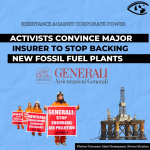New Database on World Bank Fossil Fuel Projects
First-of-its-kind Resource Catalogues $20 Billion in Dirty Energy Projects Since 1992
For more information, contact:
Daphne Wysham, in Washington, DC: 202-234-9382, x208
Stephen Kretzmann, in Brussels (cell): 301-573-2468
WASHINGTON, DC (October 29, 2001) -- The World Bank has invested over $20 billion in more than 200 projects that extract, transport, or burn fossil fuels since 1992, according to a first-of-its-kind global database launched today by the Institute for Policy Studies.
This new resource for journalists, researchers and observers of international finance and energy policy comes on the eve of two major events related to the ongoing debate on climate change: the global climate negotiations beginning on October 29, 2001, in Marrakech, and the World Bank's new Extractive Industries Review beginning also on October 29 in Brussels.
The Institute for Policy Studies' (IPS) online database, available at www.seen.org, catalogues all World Bank-financed fossil fuel projects on a map-based database, together with each project's anticipated lifetime greenhouse gas emissions. IPS found that the sum of lifetime emissions from World Bank projects financed from 1992 to the present will exceed 40 billion tons of carbon dioxide, a figure almost two times that of all global emissions from burning or flaring fossil fuels in 1998.
"At a time when global leaders are doing all they can to stop the potentially catastrophic effects of global warming, this database demonstrates that the World Bank's fossil fuel investments are contributing to the problem in a big way," said Daphne Wysham of the Sustainable Energy and Economy Network (SEEN), a project of IPS.
The World Bank is home to the key institution created during the Climate Convention at the 1992 Earth Summit, the Global Environmental Facility (GEF), which is charged with the task of financing alternative energy and energy efficiency projects. However, over the same time period, IPS research found that the World Bank and the GEF, together, have invested barely $1billion on a few dozen energy efficiency and renewable energy initiatives. Fossil fuels, some World Bank staffers claim, are essential building blocks in development. However, experience in the field and even the Bank's own internal studies suggest the exact opposite: overweening emphasis on fossil fuel investments has actually hampered progress in many developing countries, and often results in the impoverishment of the very people the Bank is intended to serve.
"From the local level, where fossil fuels extraction results in resettlement, civil unrest and environmental degradation, to the global level, where these fossil fuels lead to global warming, investment in oil, gas and coal is destabilizing for all of us," said Wysham.
The IPS global database follows previous SEEN reports that covered World Bank financing from 1992 to 1997, and from 1997 to 1998. In response to SEEN research, which catalyzed parliamentary hearings in Europe on World Bank fossil fuel investments, World Bank President James Wolfensohn pledged at the Earth Summit+5 in New York in 1997 to calculate greenhouse gas emissions for World Bank energy projects, and "where there is cause for concern, explore more climate-friendly options." However, that pledge has proven hollow, as World Bank fossil fuel lending has remained constant at over $2 billion per year.
Growing worldwide criticism of the World Bank's fossil fuel investments has prompted the Bank to undertake a major, year-long review of its oil, gas, and mining projects, to be launched October 29 in Brussels (see www.eireview.org).
"The World Bank's proposed review of its extractive industries should begin with a recognition that there is a body of evidence that suggests fossil fuel lending is bad for development, the environment, and human rights" said Steve Kretzmann, SEEN Campaign Coordinator. "The Bank must face the fact that lending for fossil fuels runs directly counter to its stated goals of poverty alleviation and sustainable development," Kretzmann added.
Vital Statistics from the SEEN global database
(Ccurrent through Sept. 30, 2001)
- Fossil fuel financing, World Bank Group, since 1992: $20.8 billion
- Estimated lifetime carbon dioxide emissions from these projects: 40.6 billion tons
- Worldwide carbon dioxide emissions from consumption/flaring of fossil fuels, 1999: 22.3 billion tons
- Renewable energy/energy efficiency financing, World Bank Group, since 1992: $900 million
- Number of World Bank Group renewable energy/energy efficiency projects, since 1992: 30
- Number of World Bank Group fossil fuel projects, since 1992: 212
- Top three recipient countries of World Bank fossil fuel aid since 1992: India ($3.196 billion), China ($2.914 billion), Russia ($2.890 billion)
- Total megawatts, fossil fuel power plant generation capacity financed by World Bank since 1992: 39,423MW
- Total megawatts, existing solar power plant generation capacity worldwide, 2000: 300MW
SEEN has also reported on the fossil fuel finances of other institutions, including U.S. institutions (Overseas Private Investment Corporation and Export-Import Bank) and the European Bank for Reconstruction and Development. These publications are available at: http://www.seen.org/pages/reports.shtml
- 107 Energy
- 194 World Financial Institutions



